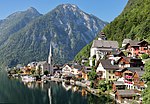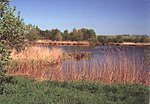The Hallstatt culture was the predominant Western and Central European archaeological culture of the Late Bronze Age (Hallstatt A, Hallstatt B) from the...
77 KB (8,526 words) - 15:20, 20 September 2024
Hallstatt (German: [ˈhalʃtat] ) is a small town in the district of Gmunden, in the Austrian state of Upper Austria. Situated between the southwestern...
24 KB (2,248 words) - 12:18, 16 September 2024
Slovakia (section Hallstatt Period)
the production of textiles. The local power of the "Princes" of the Hallstatt period disappeared in Slovakia during the century before the middle of first...
172 KB (15,653 words) - 22:41, 20 September 2024
Urnfield culture (redirect from Urnfield period)
Urnfield culture followed the Tumulus culture and was succeeded by the Hallstatt culture. Some linguists and archaeologists have associated this culture...
104 KB (11,106 words) - 16:23, 20 September 2024
Hallstatt culture. Four cultural layers were identified containing pottery ranging from the late Urnfield culture to the mid-Hallstatt culture period...
12 KB (1,513 words) - 03:48, 20 July 2024
Ancient history (redirect from Ancient period)
Iron Age in Central Europe (Hallstatt period, named for the site in present-day Austria). By the later Iron Age (La Tène period), Celts had expanded over...
98 KB (11,794 words) - 11:43, 7 September 2024
Opfermoor Vogtei (section Hallstatt Period)
which includes a shallow lake, was a supra-regional cult site from the Hallstatt Period (6th century BCE) to the Migration Age (5th century CE) developed by...
27 KB (3,327 words) - 14:17, 24 September 2023
1100 to 900 BC; Period V (late), 900 to 700 BC. The Early Iron Age included Hallstatt Period C, 700 to 600 BC, and Hallstatt Period D, 600 to 450 BC...
41 KB (5,495 words) - 21:18, 22 June 2024
Celtic centres in Central Europe, particularly during the Iron Age Hallstatt culture period. Apart from the fortified citadel, there are extensive remains...
40 KB (4,534 words) - 05:40, 5 June 2024
Hallstätter See (redirect from Lake Hallstatt)
Hallstätter See or Lake Hallstatt is a lake in Salzkammergut, Austria. It is named after Hallstatt, a small market town famous for its salt mining since...
2 KB (227 words) - 14:34, 30 July 2023
of paleofeces sampled in the salt mines of Hallstatt (Austria) showed that miners of the Hallstatt Period (800 to 400 BC) already consumed blue cheese...
28 KB (3,227 words) - 14:22, 19 September 2024
Iron Age sword (category Swords by period)
the world. The Celtic Hallstatt culture – 8th century BC – figured among the early users of iron. During the Hallstatt period, the same swords were made...
11 KB (1,456 words) - 00:51, 20 January 2024
pile dwellings around the Alps. Remains of wooden bridges from the Hallstatt period (647 BC), the Roman era (AD 165) and the Early Middle Ages (AD 741)...
9 KB (863 words) - 07:06, 7 March 2024
(Hungary) are typical Dacian bracelets of the Hallstatt period. Acâș- Săcueni are typical Dacian bracelet of Hallstatt Age Dacian gold bracelet Șimleu Silvaniei...
138 KB (15,248 words) - 18:36, 13 July 2024
La Tène culture (redirect from La Tène Period)
Roman conquest in the 1st century BC), succeeding the early Iron Age Hallstatt culture without any definite cultural break, under considerable Mediterranean...
45 KB (4,480 words) - 17:54, 2 September 2024
Urnfield culture contemporary to the Hallstatt period. Este had artistic and technical influence on the Hallstatt region to the north and the Etruscan...
8 KB (772 words) - 20:44, 8 July 2024
in the Urnfield period. During the early Iron Age Hallstatt period and into the early La Tène period the Ipf was an important 'princely seat' – a regional...
5 KB (420 words) - 15:34, 17 May 2024
V, c. 900–700 BC. The Early Iron Age included Hallstatt Period C, c. 700–600 BC, and Hallstatt Period D, c. 600–450 BC. Poland's Bronze- and Iron-Age...
14 KB (1,804 words) - 15:22, 7 September 2024
there is evidence for male wear in the early period; in a rich double burial of the Hallstatt period at Hochmichele, the man wears an iron torc and...
27 KB (3,444 words) - 02:47, 28 August 2024
inhabited since prehistoric times. Archaeological remains from the Hallstatt period have been found in the area. The nearby Tonocov Grad archaeological...
13 KB (1,229 words) - 03:10, 4 September 2024
themselves. The Proto-Celtic Hallstatt culture (8th century BC) were among the earliest users of iron swords. During the Hallstatt period, they made swords both...
23 KB (2,933 words) - 10:12, 31 July 2024
Hallstatt Period (8th–6th century BC), the decorative pattern of a dragon head or a serpent had become quite common in Dacia. In the La Tène Period (3thBC–1st...
31 KB (3,587 words) - 14:42, 23 June 2024
Salzkammergut (redirect from Hallstatt-Dachstein / Salzkammergut Cultural Landscape)
in use at least since the days of the Celtic Hallstatt culture, centered at the mining town of Hallstatt. These operations were continued by the Romans...
15 KB (1,563 words) - 09:29, 20 August 2024
The Hallstatt Museum (German: Museum Hallstatt) is a museum in Hallstatt, Upper Austria, that has an unrivalled collection of discoveries from the local...
11 KB (948 words) - 08:09, 25 December 2022
Celtic art (section Hallstatt gallery)
the archaeologist, the rich "princely" burials characteristic of the Hallstatt period greatly reduce, at least partly because of a change from inhumation...
52 KB (6,845 words) - 02:41, 18 September 2024
Slovenia (section Early modern period)
transition period between the Bronze Age to the Iron Age, the Urnfield culture flourished. Archaeological remains dating from the Hallstatt period have been...
227 KB (20,882 words) - 01:33, 12 September 2024
in quality in the 5th century, up to about 400 BC, well after the Hallstatt period had ended over much of its area. Some were found containing cremated...
16 KB (1,796 words) - 19:52, 21 August 2024
In Japanese history, the Jōmon period (縄文時代, Jōmon jidai) is the time between c. 14,000 and 300 BC, during which Japan was inhabited by a diverse hunter-gatherer...
52 KB (5,853 words) - 06:15, 14 September 2024
agriculture. Since the late Hallstatt period, the peoples living on Lake Constance are referred to as the Celts. During the La Tène period from 450 BC, the population...
98 KB (10,364 words) - 07:49, 8 September 2024
Ancient Celtic women (category Women by period)
Europe in the Late Bronze Age and early Iron Age (the Hallstatt culture). In the La Tène period they expanded, through migration and cultural transmission...
54 KB (7,682 words) - 04:00, 9 September 2024

























